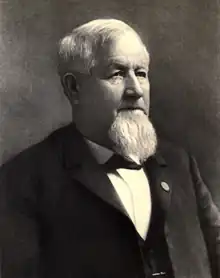| |||||||||||||||||
Majority of Illinois General Assembly needed to win | |||||||||||||||||
|---|---|---|---|---|---|---|---|---|---|---|---|---|---|---|---|---|---|
| |||||||||||||||||
| |||||||||||||||||
The 1891 United States Senate election in Illinois was held from January 13 to March 11, 1891. The contentious election was determined by a joint session of the Illinois General Assembly. The election went on for 154 ballots and cost the State of Illinois approximately $150,000.[1]
1890 general election
In the 1890 general election for the Illinois Senate and Illinois House of Representatives, voters returned 101 Democrats, 100 Republicans, and 3 Farmers' Alliance candidates to the Illinois General Assembly. This placed the balance of power with the "Big Three"; the three legislators affiliated with Farmers' Alliance. They were James Cockrell, Hosea H. Moore, and Herman Taubeneck.[2]
Initial nominations
The 37th Illinois General Assembly was convened on January 7, 1891.[3] The Republican caucus nominated Richard J. Oglesby with 48 votes on the first ballot and 64 votes on the second ballot defeating incumbent Senator Charles B. Farwell.[4] A combination of backlash from farmers, personal grudges, and a lethargic campaign for renomination doomed Farwell's candidacy at the caucus.[5] Oglesby had initially declined to be a candidate in March 1890[6] Oglesby was nominated during the House proceedings by David P. Keller of Macon County and in the Senate by George E. Bacon of Edgar County.[7][8][3] The Democratic candidate John M. Palmer was nominated during House proceedings by Frank H. Jones of Sangamon County and in the Senate by Martin Newell of Woodford County.[7][8][3] Alson Streeter the candidate of the Union Labor Party in the 1888 United States presidential election and choice of the Farmers' Alliance members, was nominated during House proceedings by James Cockrell of Marion County.[7][3]
Voting
The election was deadlocked as both the Democratic caucus and Republican caucus struggled to get the "Big Three" to support their chosen candidates. Eventually, Cockrell and Moore defected to the Democratic Party's candidate. The Republican caucus lined up unanimously behind Lindly. Herman Taubeneck remained behind Streeter.[2]
References
- ↑ W. Newcombe, Alfred (1945). "Alson J. Streeter: An Agrarian Liberal". Journal of the Illinois State Historical Society. 38 (4): 414–445. JSTOR 40188174.
- 1 2 Scott, Roy Vernon (1962). The Agrarian Movement in Illinois 1880-1896. Champaign, Illinois: University of Illinois Press. Retrieved September 23, 2022.
- 1 2 3 4 Woods, Harry (ed.). "Thirty-Seventh General Assembly 1890-1892". Illinois Blue Book 1913-1914. Springfield, Illinois: Illinois Secretary of State. pp. 393–394. Retrieved September 29, 2022.
- ↑ RICHARD J. OGLESBY THE NOMINEE. Chicago Daily Tribune (1872-1922); Chicago, Ill. [Chicago, Ill]. 16 Jan 1891: 4.
- ↑ "UNCLE DIRK" THE MAN.: Ex-Gov. Oglesby the Republican Choice for Senator. FARWELL IS BEATEN BADLY. He Receives but 30 Votes to the ExGovernor's 64. TWO BALLOTS SETTLE MATTERS. The Senator Says He Is Not Surprised at the Result. PROCEEDINGS OF THE CAUCUS IN DETAIL. The Fight Against Farwell. Protests of the Farmers. Not an Applicant for the Place. Gen. Palmer Doesn't Like It. Chicago Daily Tribune (1872-1922); Chicago, Ill.[Chicago, Ill]. 16 Jan 1891: 1.
- ↑ OGLESBY DOESN'T WANT IT.: The Ex-Governor Says He Is Not a Candidate for the Senate. Chicago Daily Tribune (1872-1922); Chicago, Ill. [Chicago, Ill]. 01 Mar 1890: 2.
- 1 2 3 NOMINATING SPEECHES IN THE HOUSE: Palmer's Name Presented by Jones and Oglesby's by Keller. Representative Jones' Speech. Nominating Oglesby. The Colored Member's Oration. Cockrell Nominating Streeter. Chicago Daily Tribune (1872-1922); Chicago, Ill. [Chicago, Ill]. 21 Jan 1891: 2
- 1 2 ORATORY IN THE SENATE.: Bacon Nominates Oglesby and Newell Presents Palmer's Name. Chicago Daily Tribune (1872-1922); Chicago, Ill. [Chicago, Ill]. 21 Jan 1891: 2.


